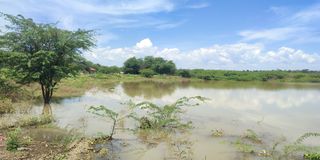Baringo schools where learners dodge hippos, and crocodiles after Lake Baringo burst its banks

Part of the school field at Loruk Primary School, Baringo North, is swallowed by the rising water levels in Lake Baringo.
What you need to know:
- The learners regularly venture to the lake’s edge, unaware of the lurking danger.
- Some fetch water, while others rinse their utensils or wash the dust from their feet—all within sight of the hippos.
Earlier this week, as the midday sun beat down on Loruk Primary School, students took their afternoon lunch break. After their meals, many retreated to the shade of trees, books in hand, preparing for their next lesson.
Just beyond the school’s boundaries, less than 50 metres away, a herd of hippos lazily waded through the waters of Lake Baringo. The lake, swollen from recent rains, has crept dangerously close to the school.
The learners regularly venture to the lake’s edge, unaware of the lurking danger. Some fetch water, while others rinse their utensils or wash the dust from their feet—all within sight of the hippos.
Apart from the hippos, Lake Baringo is also infested with crocodiles and snakes, posing a security risk to the learners at the school in Baringo North.
The water, now 50 metres higher than it was just months ago, has swallowed the school’s playing field and nearby structures. Crocodiles and hippos have been spotted dangerously close to the school compound, and the absence of a perimeter fence or protective wall leaves the students vulnerable.
Isaac Rerimoi, the school’s headteacher, explained that the water levels began rising gradually two months ago following the heavy rains that pounded the area. The boys’ pit latrines were the first to disappear beneath the rising waters, but the school’s proximity to the lake makes further flooding inevitable.
“The water has risen dramatically, flooding parts of the school compound,” Mr. Rerimoi said. “We now have 60 boarding students, and the dense overgrowth caused by the rains makes it easy for wildlife to wander into the school grounds. The danger is especially high at night.”
Nation.Africa team toured the school and counted more than 15 hippos roaming just a few metres from the school as the learners continued with their activities.
“The wildlife move out of the water into the school compound and villages, especially at night, in search of pasture, posing a threat to our boarders, who must go out to relieve themselves at the pit latrines. We also have venomous snakes coming out due to the flooding,” said the school head.
The flooding has also cut off the school's connection to the main road, forcing teachers and students to take a much longer, more treacherous detour.
This is not the first time Loruk Primary has faced such challenges. Four years ago, the school was flooded so severely that the boys’ dormitory, which had a capacity of 80 pupils, was completely submerged.
For a time, students had to use canoes to reach the school after the rising waters consumed the main roads. To remedy the situation, the government intervened and moved the institution to a safer area five kilometres away. This saw the commencement of the construction of a boys’ dormitory.
However, this turned into a white elephant, as the proposed site was far from villages where locals lived and were also on a border area faced with frequent bandit attacks, hence a security threat, the head teacher told Nation. Africa.
“The boys are now sleeping in one of the classrooms,” Mr. Rerimoi said. “But the water is rising again, and we fear the school could be submerged once more.”
This perilous situation is also being experienced at Noosukro Primary School in Baringo South, where entire sections of the school have been swallowed by the rising lake. The playing field, pit latrines, and teacher quarters have all disappeared beneath the floodwaters.
Noosukro’s headteacher, Jeremiah Nakure, told Nation. Africa that learning for the third term has yet to resume. "Our institution borders Lake Baringo, and flooding has swallowed significant parts of the school,” Mr. Nakure said. “The classrooms are next. If the heavy rains continue, we’ll be forced to relocate entirely."
In a meeting with parents last week, the Noosukro school management discussed the uncertain future. One proposed plan was to relocate the students to a nearby island if the flooding worsens.
“We might have to conduct lessons under trees,” Mr. Nakure said. “We’re considering temporary tents, but for now, the only way to reach the school is by boat. Some students may even have to wade through crocodile-infested waters to get here.”
The crisis has affected more than just education. In 2020, flooding from Lake Baringo forced students from Noosukro out of their classrooms. Transport along the Marigat-Chemolingot road, which runs adjacent to the lake, was severely disrupted, and the lake is now on the verge of swallowing the road again.
The tourism sector has not been spared either. Several hotels along the lake's edge, including Soi Safari Lodge, have been partially submerged. The lodge lost 56 rooms, a conference hall, and part of its restaurant to the rising waters.
Lake Baringo senior warden Jackson Komen confirmed the rapid rise of the lake, which has increased by 15 metres over the past three months alone.
Human activity upstream, including deforestation and poor land management, has exacerbated siltation, contributing to the flooding. The presence of hippos and crocodiles, combined with the encroaching waters, has heightened fears of human-wildlife conflict and snake bites in nearby villages.
As the water continues to rise, students and residents of the region find themselves grappling with the daunting challenge of coexisting with dangerous wildlife while their land is slowly consumed by the lake.
